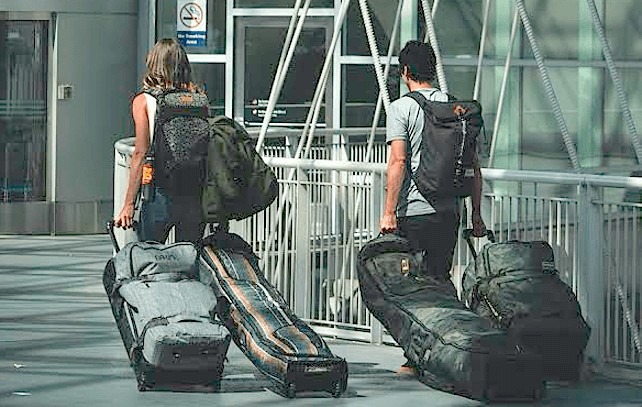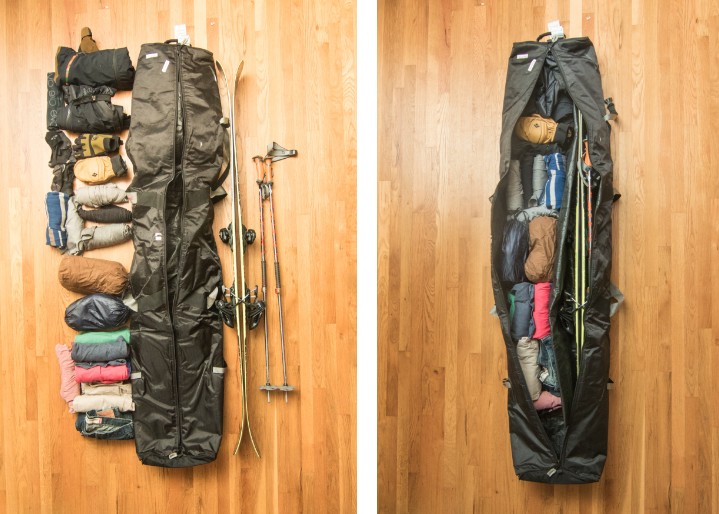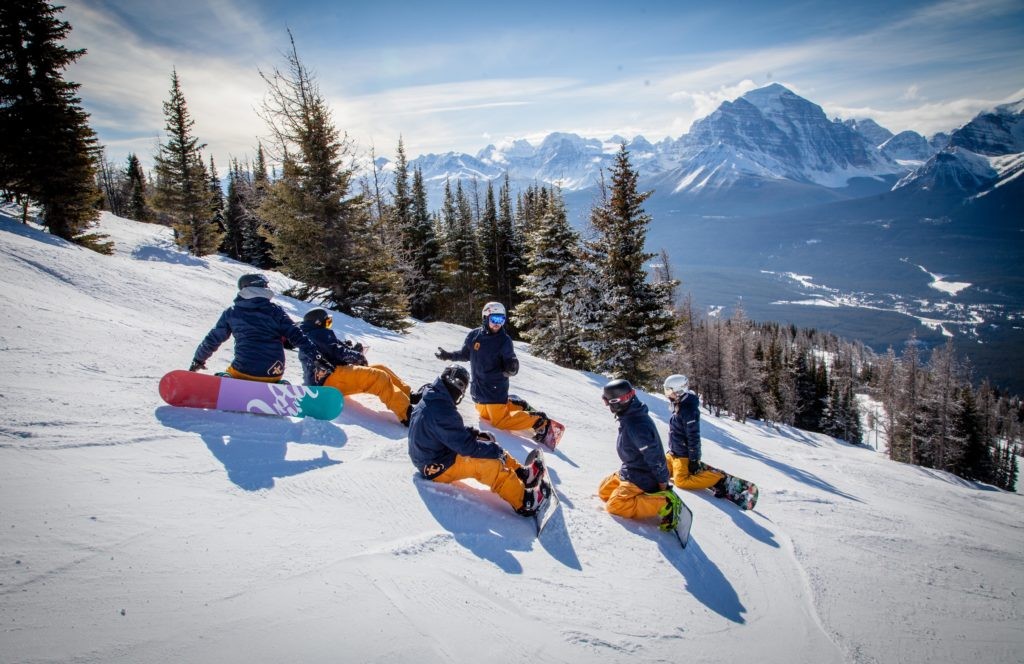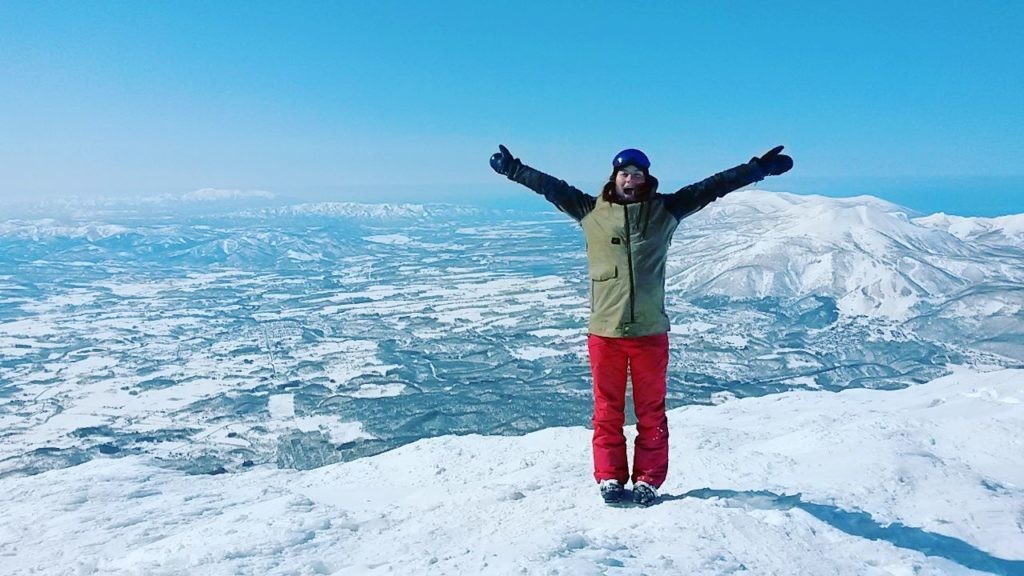Traveling with your snowboard can be an exciting adventure, but it requires careful planning. At TRAVELS.EDU.VN, we understand the nuances of snowboard travel and offer tailored solutions to make your trip seamless. With our expertise, you can enjoy a stress-free journey to your favorite slopes, backed by reliable services and up-to-date information on snowboard gear transportation.
1. What Are The Essential Steps For Packing Your Snowboard For Travel?
Packing your snowboard properly is crucial for protecting it during travel. Here’s a step-by-step guide to ensure your board arrives safely:
1. Gather Your Supplies: You’ll need a snowboard bag (preferably padded), bubble wrap, foam padding, packing tape, and any soft items like clothing to use as extra cushioning.
2. Disassemble Your Board (If Necessary): Remove the bindings if you’re concerned about space or potential damage. Mark the stance angles with tape for easy reassembly.
3. Protect The Edges: Use bubble wrap or foam padding to cover the edges of your snowboard. This prevents them from getting nicked or damaged during transit.
4. Wrap The Bindings: If you’re removing the bindings, wrap them separately in bubble wrap and secure with tape.
5. Pad The Nose And Tail: Add extra padding to the nose and tail of your snowboard. These areas are most susceptible to impact.
6. Use Clothing For Extra Cushioning: Place soft items like sweaters, socks, and pants around the snowboard inside the bag. This not only saves space in your suitcase but also provides additional protection.
7. Secure Everything: Use packing tape to secure any loose padding or wrapping. Ensure that nothing will shift during transit.
8. Check The Weight: Be mindful of airline weight restrictions. Overweight bags can incur hefty fees. A typical snowboard bag with gear should weigh under 50 pounds (23 kg) to comply with most airline regulations.
9. Label Your Bag: Clearly label your bag with your name, address, phone number, and email address. Attach a luggage tag both inside and outside the bag.
10. Consider A Wheelie Bag: If you anticipate a lot of walking, invest in a snowboard bag with wheels. This will make navigating airports and train stations much easier.
By following these steps, you can ensure your snowboard is well-protected and ready for your snowboarding adventure.
 Snowboard gear packed in a Dakine bag
Snowboard gear packed in a Dakine bag
2. How Can I Minimize Weight And Luggage When Traveling With A Snowboard?
Minimizing weight and luggage is crucial for hassle-free travel. Here are strategies to keep your baggage light and manageable:
1. Pack Only Essentials: Evaluate each item and ask if it’s truly necessary. Overpacking is a common mistake.
2. Use Clothing As Padding: Wrap your snowboard, helmet, and other gear in clothing to save space and protect your items.
3. Wear Bulky Items: Wear your ski jacket, boots, and other heavy items on the plane to reduce weight in your luggage.
4. Choose Lightweight Gear: Invest in lightweight snowboard gear and travel bags. Modern materials can significantly reduce weight.
5. Rent At Your Destination: Consider renting some gear, such as snowboard boots or helmets, at your destination to avoid carrying them.
6. Roll Your Clothes: Rolling clothes instead of folding them saves space and reduces wrinkles.
7. Use Compression Bags: Compression bags can compress bulky items like sweaters and jackets, creating more space in your luggage.
8. Share With Travel Partners: If traveling with friends or family, share items like toiletries and sunscreen to reduce individual loads.
9. Check Airline Weight Limits: Be aware of airline weight restrictions and pack accordingly to avoid overweight baggage fees.
10. Ship Your Gear: If you’re traveling for an extended period, consider shipping your snowboard and gear to your destination ahead of time.
By implementing these strategies, you can minimize weight and luggage, making your snowboard travel experience more enjoyable.
 Carefully packed snowboard gear to protect delicate items
Carefully packed snowboard gear to protect delicate items
3. Which Airlines Offer The Best Policies For Traveling With Snowboards In 2024?
Choosing the right airline can significantly impact your travel experience with a snowboard. Here are some airlines known for their favorable snowboard travel policies in 2024:
| Airline | Policy | Notes |
|---|---|---|
| Swiss Air | Includes ski equipment as a checked bag. The first piece of checked baggage is included in the price of the flight (up to 23kg). | Pack all your gear into one bag weighing 23kg max for best value. |
| Air Canada | One piece of checked luggage is included as standard (23kg), and this can include ski or snowboard equipment. | A separate boot bag is allowed if it only contains ski boots. |
| British Airways | Your first bag of 23kg is included in your airfare, which can be used for a ski or snowboard bag. | Additional bags incur extra fees. |
| Japan Airlines | Includes two 23kg bags as standard with its economy tickets. | Ideal for taking a normal suitcase and a ski/board bag without extra cost. |
| All Nippon Airways | Also includes two checked in bags of 23kg with economy tickets. | Notify them if the total dimensions of your bag exceed 158cm. |
| Finnair | On flights to Japan only, includes 2 bags with an economy fare, up to 23kg each. Skis explicitly count as one piece. | |
| Air New Zealand | Ski and snowboard equipment is included as part of the included 23kg. | Check the size of your ski or board bag, as they are strict on the dimensions allowed. |
| Emirates | Includes 32kg over two bags as standard. Ski and snowboard equipment counts as part of this allowance. | Cannot exceed this limit, and extra allowance is expensive. |
| Singapore Airlines | Sports equipment counts towards your free allowance included in your ticket (30kg usually). | You can have one snowboard bag and one normal bag included in this. |
| Qantas | Includes sports equipment as a checked baggage in your allowance of 30kg. | Extra baggage can be purchased online if needed. |
| Westjet | Lower luggage fees. First piece is $25-30 (£15-17) and second is $35-40 (£20-22) for each flight. Skis and snowboards can be larger in size than the standard dimensions stated. | Westjet flights are often the cheapest around, and with the lower luggage fees, they work out as the best bet, especially if you have two bags. |
When choosing an airline, consider factors such as baggage allowance, fees for additional bags, and overall customer service. Always double-check the airline’s website for the most up-to-date information, as policies can change.
4. What Are The Baggage Fees For Snowboards On Popular Airlines?
Understanding baggage fees is essential for budgeting your snowboard trip. Here’s a detailed look at the baggage fees for snowboards on popular airlines:
| Airline | Baggage Fee for Snowboards | Additional Notes |
|---|---|---|
| Easyjet | £37 (per flight) if booked online, £47 if paid at the airport. | Skis and snowboards count as small sports equipment (20kg allowance). Weight can be pooled between bags and across a booking. |
| Flybe | £30 per flight. | Big limit on the numbers of sports equipment they can carry on a flight. Max length of a ski bag is only 1.67m on smaller aeroplanes. |
| Air Canada | $100 CAD extra per flight (around £57) for an additional bag. | One piece of checked luggage is included as standard (23kg). |
| British Airways | £60 per flight for a second bag of 23kg. | Your first bag of 23kg is included in your airfare. |
| Westjet | First piece is $25-30 (£15-17), second is $35-40 (£20-22) for each flight. | The price of the flight doesn’t include any checked in bags. Skis and snowboards can be larger in size than the standard dimensions stated. |
| Cathay Pacific | $200 NZD (£105) per flight for an extra piece of luggage of another 23kg. | Ski and snowboard equipment is counted as one “piece” of luggage and not judged by weight on flights from Hong Kong to Auckland. Maximum size limit of only 158cm total dimensions. |
| Qatar Airways | $300 USD in advance as extra for up to 300cm total dimensions and up to 32kg. | Can be checked in as part of baggage allowance (only 20kg). |
These fees can vary, so always check the airline’s website for the most current information. Consider the total cost, including baggage fees, when booking your flight.
5. What Are The Dimensions And Weight Restrictions For Snowboard Bags?
Knowing the dimensions and weight restrictions for snowboard bags is crucial to avoid extra fees and ensure smooth travel. Here are the standard guidelines:
Weight Restrictions:
- Most airlines have a standard weight limit of 50 pounds (23 kg) for checked baggage.
- Some airlines offer a higher weight limit for sports equipment, so check with your specific airline.
- Exceeding the weight limit can result in hefty overweight baggage fees, typically ranging from $50 to $200 per flight.
Dimension Restrictions:
- Many airlines have a maximum size limit for checked baggage, often expressed as the sum of the bag’s length, width, and height.
- Standard dimension limits are around 62 inches (158 cm).
- However, many airlines make exceptions for sports equipment like snowboards, allowing for larger dimensions.
- Always verify the specific dimension restrictions with your airline to avoid issues at the airport.
Tips for Compliance:
- Weigh your bag at home before heading to the airport to ensure it meets the weight restrictions.
- Measure the dimensions of your snowboard bag to confirm it meets the airline’s size requirements.
- If your bag exceeds the limits, consider shipping your gear or renting at your destination.
Staying within the weight and dimension restrictions will help you avoid unexpected fees and ensure a hassle-free travel experience.
6. How To Protect Your Snowboard During Air Travel?
Protecting your snowboard during air travel is essential to prevent damage. Here’s how to safeguard your board:
1. Use A Padded Snowboard Bag: Invest in a high-quality, padded snowboard bag to provide a protective barrier against impacts.
2. Wrap Your Board: Wrap your snowboard in bubble wrap or foam padding, paying special attention to the edges, nose, and tail.
3. Remove Or Secure Bindings: If possible, remove your bindings and pack them separately. If not, ensure they are securely fastened and protected with padding.
4. Use Clothing For Padding: Use soft items like clothing, sweaters, and socks to fill empty spaces in the bag and provide extra cushioning.
5. Protect The Edges: Use edge protectors or foam tubing to cover the sharp edges of your snowboard.
6. Reinforce Vulnerable Areas: Add extra padding to the nose and tail of your snowboard, as these areas are most prone to damage.
7. Check For Loose Items: Ensure there are no loose items in the bag that could shift during transit and cause damage.
8. Label As Fragile: Clearly label your snowboard bag as “Fragile” to alert baggage handlers to handle it with care.
9. Consider Travel Insurance: Purchase travel insurance that covers damage to sports equipment for added peace of mind.
10. Inspect Your Board Upon Arrival: After the flight, inspect your snowboard for any signs of damage before leaving the airport.
By following these steps, you can minimize the risk of damage and ensure your snowboard arrives safely at your destination.
 Snowboarder enjoying the slopes in British Columbia, Canada
Snowboarder enjoying the slopes in British Columbia, Canada
7. What Are The Best Snowboard Destinations To Travel To?
Choosing the right destination can make your snowboard trip unforgettable. Here are some of the best snowboard destinations:
- Niseko, Japan: Known for its abundant powder snow and fantastic backcountry opportunities. Niseko offers a unique cultural experience combined with world-class snowboarding.
- Whistler Blackcomb, Canada: One of the largest ski resorts in North America, Whistler Blackcomb offers a wide variety of terrain, from gentle slopes to challenging backcountry.
- Aspen, Colorado, USA: A luxurious destination with four mountains to explore, Aspen offers excellent snowboarding conditions and a vibrant après-ski scene.
- Zermatt, Switzerland: Home to the iconic Matterhorn, Zermatt offers stunning scenery and high-altitude snowboarding, ensuring a long season.
- Queenstown, New Zealand: A hub for adventure sports, Queenstown offers fantastic snowboarding opportunities in the Southern Hemisphere winter, with stunning views and vibrant nightlife.
- Val Thorens, France: The highest ski resort in Europe, Val Thorens offers guaranteed snow and a lively atmosphere, making it a favorite among snowboarders.
- Park City, Utah, USA: The largest ski resort in the United States, Park City offers a wide range of terrain and excellent snow conditions, making it a top destination for snowboarders.
- Banff, Canada: Located in the heart of the Canadian Rockies, Banff offers breathtaking scenery and excellent snowboarding at resorts like Lake Louise and Sunshine Village.
Each of these destinations offers unique experiences and challenges, ensuring an unforgettable snowboard trip.
8. What Insurance Options Are Available For Snowboard Travel?
Travel insurance is essential when traveling with a snowboard. Here are some insurance options to consider:
- Standard Travel Insurance: Covers medical emergencies, trip cancellations, and lost or stolen luggage. Ensure it includes coverage for sports equipment.
- Sports Equipment Coverage: Specifically covers damage, loss, or theft of your snowboard and related gear.
- Winter Sports Insurance: Offers specialized coverage for winter sports activities, including snowboarding. This may include additional medical coverage for injuries sustained on the slopes.
- Rental Car Insurance: If you plan to rent a car, ensure your insurance covers damage to the vehicle, especially if driving in snowy conditions.
- Personal Liability Coverage: Protects you if you accidentally cause injury or damage to someone else’s property while snowboarding.
Tips For Choosing Insurance:
- Read the policy carefully to understand what is covered and what is excluded.
- Check the coverage limits to ensure they are sufficient for your needs.
- Compare quotes from different insurance providers to find the best deal.
- Ensure the insurance covers snowboarding in your chosen destination.
- Keep a copy of your insurance policy with you during your trip.
Having the right insurance can provide peace of mind and financial protection in case of unexpected events.
9. What To Do If Your Snowboard Is Damaged During Travel?
If your snowboard is damaged during travel, take the following steps:
1. Document The Damage: Take photos of the damage as soon as possible. This will be essential for filing a claim.
2. Report To The Airline: Report the damage to the airline immediately. Obtain a written report or reference number as proof of your claim.
3. File A Claim: File a claim with the airline for the damage to your snowboard. Provide all necessary documentation, including photos, the airline report, and proof of ownership.
4. Contact Your Insurance Provider: Contact your travel insurance provider to file a claim. Provide them with the same documentation you provided to the airline.
5. Get An Estimate For Repair: Obtain an estimate from a reputable snowboard repair shop for the cost of repairing the damage.
6. Keep All Receipts: Keep all receipts related to the damage, including repair estimates, transportation costs, and any other expenses incurred.
7. Follow Up: Follow up with both the airline and your insurance provider to ensure your claim is being processed.
8. Consider Temporary Replacement: If possible, rent a snowboard at your destination while your board is being repaired or replaced.
By taking these steps promptly, you can maximize your chances of receiving compensation for the damage to your snowboard.
 Japanese snowboarders in Niseko
Japanese snowboarders in Niseko
10. What Are The Best Ways To Transport Your Snowboard From The Airport To Your Accommodation?
Transporting your snowboard from the airport to your accommodation requires planning. Here are the best options:
1. Airport Shuttle: Many ski resorts offer airport shuttle services that can transport you and your snowboard directly to your accommodation.
2. Private Transfer: Hire a private transfer service for a more comfortable and convenient option. They will meet you at the airport and transport you directly to your destination.
3. Rental Car: If you plan to explore the area, renting a car is a good option. Ensure the car has enough space for your snowboard and gear, or consider renting a car with a ski rack.
4. Public Transportation: Use public transportation, such as buses or trains, to reach your accommodation. This can be a more affordable option, but it may require more planning and transfers.
5. Taxi Or Ride-Sharing Service: Take a taxi or use a ride-sharing service like Uber or Lyft to reach your accommodation. Ensure the vehicle can accommodate your snowboard.
Tips For Transportation:
- Book your transportation in advance, especially during peak season.
- Confirm that the transportation service can accommodate your snowboard and gear.
- Check the cost of transportation to compare different options.
- Consider the distance and travel time to your accommodation.
- Have the address of your accommodation readily available for the driver.
Choosing the right transportation method will ensure a smooth and stress-free journey from the airport to your accommodation.
Planning a snowboard trip involves many details, from packing your gear to choosing the right airline and destination. By following these tips and utilizing the resources at TRAVELS.EDU.VN, you can ensure a memorable and hassle-free snowboarding adventure.
Ready to book your dream snowboard trip? Contact TRAVELS.EDU.VN today at 123 Main St, Napa, CA 94559, United States, or call us at +1 (707) 257-5400. Visit our website at travels.edu.vn to explore our exclusive travel packages. Let us help you create the perfect snowboard getaway.
FAQ About Traveling With Snowboard
1. What is the best type of bag for traveling with a snowboard?
The best type of bag is a padded snowboard bag, preferably with wheels for easy transport. Padded bags offer protection, while wheels reduce the strain of carrying heavy gear.
2. Can I bring my snowboard as checked baggage?
Yes, most airlines allow snowboards as checked baggage. However, it’s essential to check the airline’s specific policies regarding size, weight, and fees.
3. How much does it cost to bring a snowboard on a plane?
The cost varies by airline. Some include it as part of your standard baggage allowance, while others charge extra fees ranging from $25 to $100 or more per flight.
4. What is the weight limit for a snowboard bag on most airlines?
The standard weight limit is typically 50 pounds (23 kg). Exceeding this limit can result in overweight baggage fees.
5. How can I protect my snowboard from damage during travel?
Wrap your snowboard in bubble wrap or foam padding, especially around the edges, nose, and tail. Use clothing as extra cushioning and invest in a padded snowboard bag.
6. Do I need special insurance for snowboard travel?
While not always required, it’s advisable to have travel insurance that covers sports equipment. This protects you against damage, loss, or theft of your snowboard.
7. Can I rent a snowboard at my destination instead of bringing my own?
Yes, renting is a convenient option, especially if you want to avoid baggage fees or the hassle of transporting your board. Many resorts offer snowboard rentals.
8. What should I do if my snowboard is damaged during a flight?
Report the damage to the airline immediately and obtain a written report. File a claim with the airline and your travel insurance provider, providing photos and documentation.
9. Are there any airlines that offer free snowboard transport?
Some airlines, like Swiss Air and Japan Airlines, include ski equipment as part of their standard baggage allowance, potentially offering free snowboard transport.
10. How far in advance should I book my flight when traveling with a snowboard?
It’s best to book your flight well in advance, especially during peak season, to secure the best prices and ensure there is space for your snowboard.